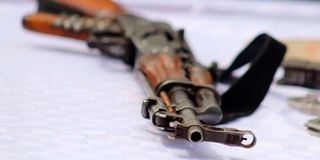Premium
Banditry: Rogue policemen renting out arms

The sophisticated weapons fuelling banditry and cattle rustling are sourced from police stockpiles according to KNFP.
Rogue police officers are leasing weapons to bandits raining terror in parts of the country, a State security agency has warned.
The sophisticated weapons fuelling banditry and cattle rustling in Baringo, West Pokot, Isiolo, Samburu, Turkana and Marsabit counties are sourced from police stockpiles, according to the Kenya National Focal Point (KNFP) on small arms and light weapons.
These are stockpiles from armouries at local police stations and in neighbouring countries.
Locally sourced weapons originate from bandits breaking into police stations and stealing from the armouries and when security forces are overpowered by bandits, said Amos Katana, KNFP’s assistant director of arms control and management.
The weapons also come from rogue officers who lend out their weapons to bandits.
Those sourced from neighbouring countries can be traced to nations that are in conflict and the bandits bribe their way into the country.
“This is how these firearms are circulating and getting into these bandits’ hands,” Mr Katana said.
He spoke during the Regional Centre on Small Arms’ (RECSA) commemoration of 22 years since the signing of the Nairobi declaration on the problem of illicit and small arms and light weapons in the Great Lakes region, Horn of Africa and bordering states.
A RECSA report on the nexus between illicit flow of small arms and light weapons proliferation and cattle rustling shows that increased commercialisation of cattle rustling has also raised demand for sophisticated weapons.
“Local business persons and politicians perpetuate this emerging trend by funding raids in order to sell cattle on the black market for export to the Gulf states such as Saudi Arabia,” the report notes.
This explains why well-connected individuals have been blamed for the violence in Pokot and Turkana. They are reported to have exploited local communities’ grievances against the government to create heavily armed private armies that, apart from providing local security, go on cattle raids.
Last year, the former Rift Valley regional coordinator George Natembeya shocked the country when he said that bandits were using heavy weapons, including M16 rifles, in their attacks that left police officers exposed with their AK-47 and G3 rifles.
He said M16s are only used by foreign militaries during their training in Kenya, prompting a response from the British government in which officials denied claims that weapons from the British Army Training Unit in Kenya (Batuk) were used in attacks in Laikipia County.
“We are certain there are no Batuk weapons circulating in Kenya. We do a 100 percent daily quantity check and a 100 per cent weekly check by individual serial number and none are missing,” the British High Commissioner said.
Weapons only exist in two forms – homemade and legal firearms.
“All weapons are legal until they are in the wrong hands and the process of getting to the wrong hands can happen during their shipment to a country or at the point of exit or entry and when there’s a political conflict in the country where you find a section of the military hiding weapons in the bush to fight the government and also through sale of the weapons through corruption,” an official said.
In 2020, 15 countries including Kenya, Uganda, Somalia and Ethiopia agreed to enforce the principles of disarmament that included establishing guidelines on marking firearms and putting in place laws to control the proliferation of small arms.
But two decades later, the problem remains in Northern Kenya, with bandit attacks happening more frequently and assisted by sophisticated weapons.
Small weapons are still finding their way to illegal hands as they are easy to buy, carry and conceal. A majority of bandits use the AK-47s.
The government plans to burn another stockpile of over 5,000 small and light weapons this year, some of which, like last year, were surrendered to chiefs and police stations.
Armed conflicts had led to the displacement of 25 million people across the world in 2019. They have also led to destruction of infrastructure and loss of millions of lives.





